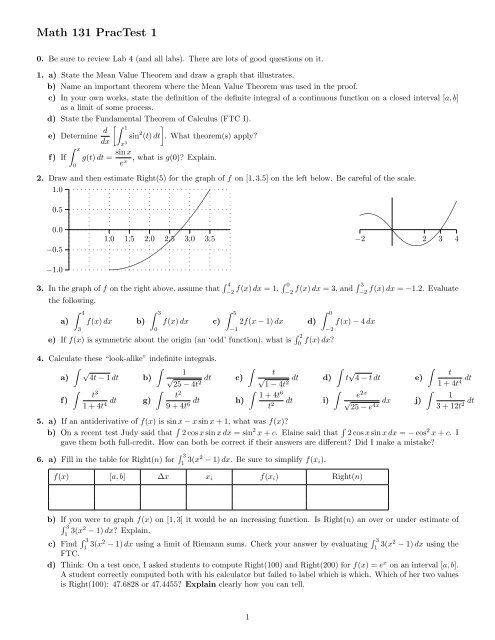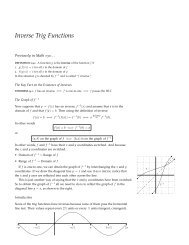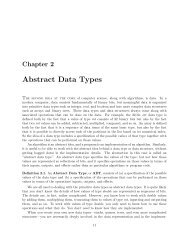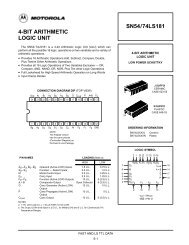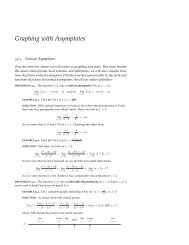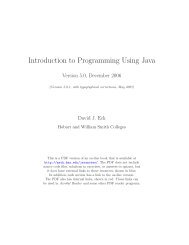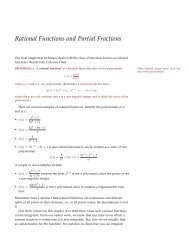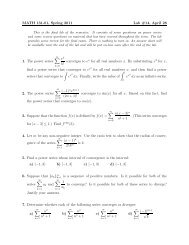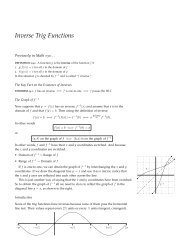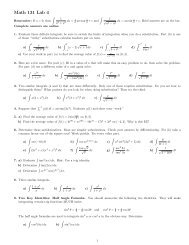You also want an ePaper? Increase the reach of your titles
YUMPU automatically turns print PDFs into web optimized ePapers that Google loves.
<strong>Math</strong> <strong>131</strong> <strong>PracTest</strong> 1<br />
0. Be sure to review Lab 4 (and all labs). There are lots of good questions on it.<br />
1. a) State the Mean Value Theorem and draw a graph that illustrates.<br />
b) Name an important theorem where the Mean Value Theorem was used in the proof.<br />
c) In your own works, state the definition of the definite integral of a continuous function on a closed interval [a, b]<br />
as a limit of some process.<br />
d) State the Fundamental Theorem of Calculus (FTC I).<br />
e) Determine d [∫ 1<br />
]<br />
sin 2 (t) dt . What theorem(s) apply?<br />
dx x<br />
∫ 3 x<br />
f) If g(t) dt = sin x<br />
e x , what is g(0)? Explain.<br />
0<br />
2. Draw and then estimate Right(5) for the graph of f on [1, 3.5] on the left below. Be careful of the scale.<br />
.<br />
1.0<br />
0.5<br />
.<br />
0.0<br />
−0.5<br />
−1.0<br />
1.0 1.5 2.0 2.5 3.0 3.5<br />
−2 2 3 4<br />
3. In the graph of f on the right above, assume that ∫ 4<br />
−2 f(x) dx = 1, ∫ 0<br />
−2 f(x) dx = 3, and ∫ 3<br />
f(x) dx = −1.2. Evaluate<br />
−2<br />
the following.<br />
a)<br />
∫ 4<br />
3<br />
f(x) dx b)<br />
∫ 3<br />
0<br />
f(x) dx c)<br />
∫ 5<br />
−1<br />
2f(x − 1) dx d)<br />
e) If f(x) is symmetric about the origin (an ‘odd’ function), what is ∫ 2<br />
f(x) dx?<br />
0<br />
4. Calculate these “look-alike” indefinite integrals.<br />
∫ ∫<br />
√4t 1<br />
a) − 1 dt b) √ dt<br />
25 − 4t<br />
2<br />
f)<br />
∫<br />
t 3<br />
∫<br />
1 + 4t 4 dt g)<br />
c) ∫<br />
t<br />
√<br />
1 − 4t<br />
2 dt<br />
t 2<br />
∫ 1 + 4t<br />
6<br />
9 + 4t 6 dt h)<br />
∫ 0<br />
t 2 dt i)<br />
−2<br />
d) ∫<br />
f(x) − 4 dx<br />
∫<br />
t √ 4 − t dt e)<br />
e 2x<br />
√<br />
25 − e<br />
4x dx<br />
∫<br />
j) ∫<br />
t<br />
1 + 4t 4 dt<br />
1<br />
3 + 12t 2 dt<br />
5. a) If an antiderivative of f(x) is sin x − x sin x + 1, what was f(x)?<br />
b) On a recent test Judy said that ∫ 2 cos x sin x dx = sin 2 x + c. Elaine said that ∫ 2 cos x sin x dx = − cos 2 x + c. I<br />
gave them both full-credit. How can both be correct if their answers are different? Did I make a mistake?<br />
6. a) Fill in the table for Right(n) for ∫ 3<br />
1 3(x2 − 1) dx. Be sure to simplify f(x i ).<br />
f(x) [a, b] ∆x x i f(x i ) Right(n)<br />
b) If you were to graph f(x) on [1, 3] it would be an increasing function. Is Right(n) an over or under estimate of<br />
∫ 3<br />
1 3(x2 − 1) dx? Explain.<br />
c) Find ∫ 3<br />
1 3(x2 − 1) dx using a limit of Riemann sums. Check your answer by evaluating ∫ 3<br />
1 3(x2 − 1) dx using the<br />
FTC.<br />
d) Think: On a test once, I asked students to compute Right(100) and Right(200) for f(x) = e x on an interval [a, b].<br />
A student correctly computed both with his calculator but failed to label which is which. Which of her two values<br />
is Right(100): 47.6828 or 47.4455? Explain clearly how you can tell.<br />
1
7. Determine these indefinite and definite integrals:<br />
a)<br />
e)<br />
∫<br />
∫ 1<br />
0<br />
8 sec(4πx) tan(4πx), dx b)<br />
e x − e −x<br />
e x dx<br />
+ e−x f)<br />
∫ π<br />
∫ e<br />
√<br />
t<br />
√<br />
t<br />
dt c)<br />
π<br />
x 2 sin 5 (x) dx g)<br />
∫<br />
∫<br />
z tan(6z 2 + 1) dz d)<br />
sec( π 4<br />
x) dx<br />
h)<br />
∫<br />
∫<br />
sin(sin t) cos t dt<br />
sec 2 ( π 4<br />
x) dx<br />
8. The graph of f(t) is given below on the left. Answer the following questions about F (x) =<br />
a) On what interval(s) is F increasing? Explain.<br />
b) At what point(s), if any, does F have a local min? Explain.<br />
c) On what interval(s) is F concave down? Explain.<br />
d) Does F have any points of inflection? Explain.<br />
e) Fill in the the table below. Your values should be reasonably accurate.<br />
x 0 1 2 3 4 5 6 7 8<br />
F (x) = ∫ x<br />
f(t) dt<br />
0<br />
∫ x<br />
0<br />
f(t) dt.<br />
f) Graph F (x) on the axes on the right using your table values and knowledge about maxs and mins.<br />
6<br />
6<br />
5<br />
4<br />
f(t)<br />
.<br />
5<br />
4<br />
3<br />
3<br />
2<br />
2<br />
1<br />
1<br />
0<br />
−1<br />
1 2 3 4 5 6 7 8<br />
0<br />
−1<br />
1 2 3 4 5 6 7 8<br />
−2<br />
−2<br />
9. Think and Interpret: The velocity of an object v(t) in m/s is graphed above on the left (same graph as in previous<br />
question).<br />
a) When is the object moving backwards? Explain.<br />
b) Assume that the initial position of the object is s(0) = 0. Fill in the row in the table for the position s(t) for the<br />
object. Then graph the position function on the axes above on the right.<br />
t 0 1 2 3 4 5 6 7 8<br />
Position s(t)<br />
Distance Traveled = ∫ b<br />
|v(t)| dt<br />
0<br />
c) What is v ave on the interval [0, 8]? (Hint: Use the v ave formula and your work above.) At what time(s) t did v ave<br />
occur (i.e., when was v(t) actually equal to v ave ? Explain.<br />
d) Speed is |v(t)|. Graph the speed function for the object on the axes on the left. Distance traveled is the integral<br />
of the speed: ∫ b<br />
|v(t)| dt. Fill in the row in the table above for the distance traveled by the object.<br />
0<br />
2
10. When making up this question, the printer jammed and only part of the graph of a differentiable function F (x) was<br />
printed out, as shown below. Nonetheless, the graph still provides enough information for you to precisely evaluate<br />
∫ 8<br />
1 F ′ (x) dx. What is the value of this integral. (Look carefully at the integrand.)<br />
4<br />
.•<br />
3<br />
2<br />
•<br />
1<br />
0<br />
−1<br />
−2<br />
1 2 3<br />
.<br />
5 6 7 8<br />
← Graph of F (x).<br />
11. a) Suppose that the acceleration of an object is a(t) = e 2t and that v(0) = 2 and s(0) = 1, where v and s have their<br />
usual meaning. Find s(t).<br />
b) Suppose instead that a(t) = 24t 2 + 12t and that s(0) = 4 and s(1) = 8. Find s(t).<br />
12. Evaluate the following expression:<br />
∫<br />
d 2<br />
4t 3 e t dt<br />
dx x 2<br />
13. On Mars the acceleration due to gravity equals 0.39 that of earth or −12.5 ft/sec/sec. Suppose that a Martian calculus<br />
student throws his calculus text upward at 25 ft/sec off the roof of a building.<br />
a) If it takes 6 seconds to hit the ground, how high is the building?<br />
b) What was the velocity of the book when it the ground?<br />
14. Let f(x) = x 2 − x on the interval [1, 3]. Suppose we want to find Right(n) for this function.<br />
a) Determine the expressions for ∆x, x k , and f(x k ). Be sure to simplify where possible.<br />
b) Determine and simplify the expression for Right(n).<br />
c) Evaluate ∫ 3<br />
1 x2 − x dx as a limit of Riemann sums.<br />
d) Check your answer by using the Fundamental Theorem of Calculus.<br />
15. One of the integral properties states that if we switch the limits of integration, the sign of the integral is switched:<br />
∫ a<br />
b<br />
f(x) dx = −<br />
∫ b<br />
a<br />
f(x) dx.<br />
Give a brief explanation of why this should be so. Hint: Think about ∆x.<br />
16. Use the graph f below to draw and then estimate the left-hand sum Left(6) for the given function on [1, 4].<br />
4<br />
3<br />
.<br />
2<br />
1<br />
0<br />
−1<br />
1 2 3 4<br />
−2<br />
3
17. Three similar integrals.<br />
∫ 1 + x<br />
4<br />
a) dx b)<br />
x<br />
∫<br />
∫<br />
x<br />
1 + x 2 dx c)<br />
x 2<br />
1 + x 6 dx<br />
18. My Honda Accord accelerates from 0 to 88 ft/sec (60 mph) in 13 seconds. Assume that acceleration is a constant, a.<br />
a) Find the velocity function of the car (using the velocities at the two times you can eliminate any constants from<br />
this function).<br />
b) How far does it travel in this 13 second period?<br />
19. A balloon, rising vertically with a velocity of 8 ft/s, releases a sandbag at the instant it is 64 ft above the ground.<br />
a) How many seconds after its release will the bag strike the ground? Remember a(t) = −32 ft/s 2 .<br />
b) At what velocity does it hit the ground?<br />
20. a) Find the average value of f(t) = t<br />
1+3t 2 on [0, 2].<br />
b) Find the average value of f(t) = 2t 999 + πt 1001 − 6t 47 − 17t 5 + cos(πt) on [−1/2, 1/2]. Why is this EZ?<br />
21. a) Page 379 #9. (Answers in text.)<br />
b) Page 379 #23. (Answers in text.)<br />
22. Area between curves: See Assignment from Day 12 and the associated WeBWork problems (and all of the examples<br />
on line in the Notes for Day 12).<br />
23. Determine<br />
∫<br />
a) cos 2 (6x) dx b)<br />
∫<br />
sin 2 (−2πx) dx<br />
Added From Monday’s Class<br />
24. Set up the integrals using the functions f(x), g(x), and h(x) and their points of intersection that would be used to<br />
find the shaded areas in the three regions below.<br />
5<br />
4<br />
3<br />
2<br />
1<br />
0<br />
y = g(x)<br />
Shaded<br />
y = f(x)<br />
0 1 2 3 4 5 6<br />
.<br />
.<br />
5<br />
4<br />
3<br />
2<br />
1<br />
0<br />
y = g(x)<br />
Shaded<br />
h(x)<br />
f(x)<br />
.<br />
...... .<br />
0 1 2 3 4 5 6<br />
25. Sketch the regions for each of the following problems before finding the areas.<br />
a) Find the area enclosed by the curves y = x 3 and y = x 2 . (Answer: 1/12)<br />
b) Find the area enclosed by the curves y = x 3 + x and y = 3x 2 − x. (Answer: 1/2)<br />
.<br />
5<br />
4<br />
3<br />
2<br />
1<br />
0<br />
g(x)<br />
Sh<br />
f(x)<br />
Sh<br />
0 1 2 3 4 5 6<br />
c) Find the area between the curves f(x) = cos x + sin x and g(x) = cos x − sin x over [0, 2π]. (Answer: 8)<br />
.<br />
.<br />
4
<strong>Math</strong> <strong>131</strong>: Answers to Practest 1<br />
1. a) Mean Value Theorem: See page 276.<br />
b) FTC II or Mean Value Theorem for Integrals.<br />
c) Partition the interval [a, b] into n equal width subintervals using points<br />
a = x 0 < x 1 < x 2 < · · · < x n = b.<br />
The definite integral of a continuous function f on a closed interval [a, b] is<br />
∫ b<br />
a<br />
f(x) dx = lim<br />
n→∞<br />
n∑<br />
f(c i)∆x,<br />
where ∆x = b−a and ci is some point in the in i-th subinterval.<br />
n<br />
[∫ 1<br />
] [<br />
d<br />
d) sin 2 (t) dt = d ∫ ]<br />
x<br />
3<br />
− sin 2 (t) dt = sin 2 (x 3 ) · 3x 2 , where we used FTC II and the chain rule.<br />
dx<br />
dx<br />
x 3 1<br />
[∫<br />
e) FTC II implies g(x) = d<br />
x<br />
]<br />
g(t) dt = d [ ] sin x<br />
= ex cos x − e x sin x<br />
. So g(0) = e0 cos 0+e 0 sin 0<br />
= 1.<br />
dx<br />
dx e x e 2x e 0<br />
0<br />
i=1<br />
2. ∆x = 3.5−1 = 1 1<br />
. So Right(5) = (−.9) · + (−0.7) · 1 + (−0.3) · 1 + (0.3) · 1 + (1) · 1 = −0.3.<br />
5 2 2 2 2 2 2<br />
1.0<br />
.<br />
0.5<br />
.<br />
0.0<br />
−0.5<br />
1 2 3 4<br />
−2 2 3 4<br />
−1.0<br />
3. Use basic integral properties.<br />
a)<br />
b)<br />
d)<br />
∫ 4<br />
3<br />
∫ 3<br />
0<br />
∫ 0<br />
f(x) dx =<br />
f(x) dx =<br />
∫ 4<br />
f(x) dx −<br />
−2<br />
∫ 3<br />
f(x) dx −<br />
−2<br />
∫ 3<br />
f(x) dx = 1 − (−1.2) = 2.2<br />
−2<br />
∫ 0<br />
2<br />
f(x) dx = −1.2 − 3 = −4.2 c)<br />
f(x) − 4 dx = 3 + (−4)[0 − (−2)] = −5 e)<br />
−2<br />
∫ 5<br />
2f(x − 1) dx = 2<br />
−1<br />
∫ 2<br />
0<br />
f(x) dx = −<br />
∫ 0<br />
∫ 4<br />
f(x) dx = 2<br />
−2<br />
f(x) dx = −3<br />
−2<br />
(horizontal shift)<br />
4. a) u = 4t − 1, 1 du = dt. ∫<br />
1<br />
4 4 u 1/2 du = 1 6 u3/2 + c = 1 (4t − 6 1)3/2 + c.<br />
b) Use ∫ a<br />
√1−u 2<br />
du = arcsin u + c with 2 a a2 = 25 so a = 5, u 2 = 4t 2 , so u = 2t, 1 du = dt. ∫<br />
1<br />
2 2<br />
1<br />
2t<br />
arcsin( ) + c.<br />
2 5<br />
c) u = 1 − 4t 2 , du = −8t dt, − 1 du = t dt. ∫ √<br />
t<br />
dt = − ∫<br />
1<br />
8<br />
1−4t 2 8<br />
√<br />
1<br />
du = − 1 u 1/2 4 u1/2 + c = − 1 4 1 − 4t2 + c.<br />
1<br />
√5 2 −u 2 du = 1 2 arcsin( u 5 ) + c =<br />
d) Method 1: u = √ 4 − t, so u 2 = 4 − t, so u 2 − 4 = t so 2u du = dt. ∫ t √ 4 − t dt = ∫ (u 2 − 4) · u · 2u du = ∫ 2u 4 − 8u 2 du =<br />
2<br />
5 u5 − 8 3 u3 + c = 2 5 u5 − 8 3 u3 + c = 2 (4 − 5 t)5/2 − 8 (4 − 3 t)3/2 + c<br />
d) Method 2: u = 4 − t, so 4 − u = t and −du = dt. − ∫ (4 − u)u 1/2 du = − ∫ 4u 1/2 − u 3/2 du = − 8 3 u3/2 + 2 5 u5/2 + c =<br />
2<br />
(4 − 5 t)5/2 − 8 (4 − 3 t)3/2 + c.<br />
e) u 2 = 4t 4 , u = 2t 2 , 1 du = tdt. ∫<br />
1 1<br />
du = 1 arctan u + c = 1 4 4 1+u 2 4 4 arctan(2t2 ) + c.<br />
f) u = 1 + 4t 4 1<br />
, du = ∫<br />
16 t3 1<br />
dt. 1 du = 1 1<br />
ln |u| + c = ln(1 + 16 u 16 16 4t4 ) + c.<br />
g) a 2 = 9 = 3 2 , u 2 = 4t 6 , u = 2t 3 , 1 du = ∫<br />
6 t2 dt.<br />
1<br />
6<br />
1<br />
du = 1 · 1 arctan( u ) + c = 1<br />
2t3<br />
arctan( ) + c.<br />
3 2 +u 2 6 3 3 18 3<br />
h) ∫ 1+4t 6<br />
dt = ∫ t −2 + 4t 4 dt = −t −1 + 4 t 2 5 t5 + c. (Just divide first by t 2 .)<br />
i) Use ∫ √<br />
a 2<br />
du = arcsin u +c with<br />
1−u 2 a a2 = 25 so a = 5, u 2 = e 4x , so u = e 2x , 1 du = ∫<br />
2 e2x dx. 1 2<br />
1<br />
e2x<br />
arcsin( ) + c. 2 5<br />
5<br />
1<br />
√5 2 −u 2 du = 1 2 arcsin( u 5 )+c =
j) u 2 = 4t 2 ⇒ u = 2t ⇒ du = 2 dt ⇒ 1 du = dt. So<br />
2<br />
∫<br />
1<br />
√ dt = 1 ∫<br />
1 − 4t<br />
2 2<br />
1<br />
√ du = 1 1 − u<br />
2 2 arcsin u + c = 1 arcsin 2t + c.<br />
2<br />
k)<br />
∫<br />
1<br />
3 + 12t dt = 1 ∫<br />
2 3<br />
1<br />
1 + 4t dt. Use 2 u2 = 4t 2 ⇒ u = 2t ⇒ du = 2 dt ⇒ 1 du = dt. So<br />
2<br />
∫<br />
∫<br />
1<br />
3<br />
1<br />
1 + 4t dt = 1 2 3 · 1<br />
2<br />
1<br />
1 + u du = 1 2 6 arctan u + c = 1 arctan 2t + c.<br />
6<br />
5. a) Since ∫ f(x) dx = sin x − x sin x + 1, then f(x) = d (sin x − x sin x + 1) = cos x − sin x − x cos x.<br />
dx<br />
d<br />
b) No. Just take the derivatives of each:<br />
dx (sin2 x + c) = 2 sin x cos x while d (− dx cos2 x + c) = −2 cos x(− sin x) = 2 sin x cos x<br />
also. The two antidervatives differ by a constant since sin 2 x = − cos 2 x + 1.<br />
6. a)<br />
f(x) [a, b] ∆x x i f(x i) Right(n)<br />
) n∑<br />
(<br />
3(x 2 2<br />
4i<br />
− 1) [1, 3] 1 + 2i 3 + 4i<br />
2<br />
3<br />
n<br />
n n<br />
(<br />
4i 2<br />
n 2<br />
i=1<br />
n 2<br />
+ 4i<br />
n<br />
) ( 2<br />
n<br />
b) Since the function is increasing (f ′ (x) = 6x > 0 on [1, 3]), Right(n) is an overestimate of ∫ 3<br />
1 3x2 − 3 dx because f(x i) will<br />
be greater than any value of f(x) in [x i−1, x i]<br />
7. a)<br />
c) Right(n) = 3<br />
So<br />
∫ 3<br />
1<br />
n∑<br />
[<br />
4i<br />
2<br />
i=1<br />
n 2<br />
+ 4i<br />
n<br />
= 4<br />
]<br />
· 2<br />
n = 24<br />
n 3<br />
n∑<br />
i=1<br />
i 2 + 24<br />
n 2<br />
n∑<br />
i=1<br />
)<br />
[ ] [ ]<br />
i = 24 n(n + 1)(2n + 1)<br />
+ 24 n(n + 1)<br />
n 3 6<br />
n 2 2<br />
[ ]<br />
2n 2 + 3n + 1 12n + 12<br />
+ = 8 + 12<br />
n 2 n<br />
n + 4 12 24<br />
+ 12 + = 20 +<br />
n2 n n + 4 n 2<br />
∫ 3<br />
∣<br />
3(x 2 − 1) dx = lim Right(n) = 20 and using the FTC, 3x 2 − 3 dx = x 3 − 3x 3 = (27 − 9) − (1 − 3) = 20.<br />
n→∞ 1<br />
d) Since e x is an increasing function Right(n) is an overestimate. Since the estimates improve (smaller overestimate) as n gets<br />
larger, then Right(100) > Right(200). So Right(100) = 47.6828.<br />
8<br />
sec(4πx) + c = 2 sec(4πx) + c. (Mental adustment)<br />
4π π<br />
b) u = √ t, 2 du = 1 √<br />
t<br />
dt. 2 ∫ e u du = 2e u + c = 2e √t + c.<br />
c) u = 6z 2 + 1, du = 12z dz,<br />
1<br />
12 du = z dz. So ∫ z tan(6z 2 + 1) dz = 1 12<br />
d) u = sin t, du = cos t dt. ∫ sin u du = − cos(u) + c = − cos(sin t) + c.<br />
1<br />
∫ tan u du =<br />
1<br />
1<br />
ln | sec u| + c = ln | 12 12 sec(6z2 + 1)| + c.<br />
e) u = e x + e −x , du = (e x − e −x )dx. Change the limits: When x = 0, u = e 0 + e 0 = 2; when x = 1, u = e + e −1 . So<br />
f)<br />
∫ π←<br />
π←<br />
∫ 1<br />
x 2 sin 5 (x) dx = 0. Integral property.<br />
g) ∫ sec( π x) dx = 4 ln | sec( π x) + tan sec( π x)| + c. “Adjust!”<br />
4 π 4 4<br />
h) ∫ sec 2 ( π x) dx = 4 tan( π x) + c. “Adjust!”<br />
4 π 4<br />
0<br />
∫<br />
e x − e −x<br />
e+e<br />
−1<br />
∣<br />
e x + e dx = 1 ∣∣<br />
e+e −1<br />
−x u du = ln |u| = ln |e + e −1 | − ln 2.<br />
2<br />
2<br />
8. The graph of f(x) is given below on the left. Answer the following questions about F (x) = ∫ f(x) dx.<br />
a) F incresasing, so F ′ = f > 0: [0, 2.5] and [5.5, 8].<br />
b) Local min when F ′ = f changes from negative to positive: x = 5.5<br />
c) ∫ b<br />
f(t) dt is just the net area under the curve from 0 to b.<br />
0<br />
b 0 1 2 3 4 5 6 7 8<br />
F (b) = ∫ b<br />
f(t) dt 0 2 4 3.8 2.1 0.4 0.4 2.6 6<br />
0<br />
6
6<br />
6<br />
.<br />
5<br />
4<br />
f(t)<br />
.<br />
5<br />
4<br />
F (t) = s(t)<br />
3<br />
3<br />
2<br />
2<br />
1<br />
1<br />
0<br />
−1<br />
1 2 3 4 5 6 7 8<br />
0<br />
−1<br />
1 2 3 4 5 6 7 8<br />
−2<br />
−2<br />
9. a) When is the object moving backwards? v < 0 so [2, 5, 5.5].<br />
b) Negative acceleration when a = v ′ < 0: so [1, 4].<br />
c) Position is the net area under the curve (same table as above).<br />
t 0 1 2 3 4 5 6 7 8<br />
Position s(t) 0 2 4 3.8 2.1 0.4 0.4 2.6 6<br />
Distance Traveled 0 2 4 4.8 6.5 8.2 9 11.2 14.6<br />
∫<br />
d) v ave = 1 8<br />
v(t) dt = 1 [s(8) − s(0)] = 1 (6 − 0) = 3 . vave occurred at c = 2.2 and 5.8. [Use the graph of v(t) = f(t).]<br />
8−0 0 8 8 4<br />
10. From the graph we see that F (1) = 2 and F (8) = 4. So ∫ ∣ 8<br />
F ′ (x) dx = F (x) 8 = F (8) − F (1) = 4 − 2 = 2.<br />
1 1<br />
11. a) Integrate twice: v(t) = ∫ e 2t dt = 1 2 e2t + c. v(0) = 2 = 1 2 + c ⇒ c = 3 2 . s(t) = ∫ 1<br />
2 e2t + 3 2 dt = 1 4 e2t + 3 2 t + c.<br />
s(0) = 1 = 1 4 + c ⇒ c = 3 4 . So s(t) = 1 4 e2t + 3 2 t + 3 4 .<br />
b) v(t) = ∫ 24t 2 + 12t dt = 8t 3 + 6t 2 + c. So s(t) = ∫ 8t 3 + 6t 2 + c dt = 2t 4 + 2t 3 + ct + d. Now s(0) = 4 = d. So<br />
s(1) = 8 = 2 + 2 + c + 4 ⇒ c = 0. So s(t) = 2t 4 + 2t 3 + 4.<br />
12. By FTC II<br />
∫ (<br />
2<br />
d<br />
4t 3 e t dt = d ∫ )<br />
x<br />
2<br />
− 4t 3 e t dt = −4(x 2 ) 3 e x2 · 2x = −8x 7 e x2 .<br />
dx<br />
dx<br />
x 2 2<br />
13. a) Given s ′′ (t) = −12.5, s ′ (0) = 25. Find s(0). Then s ′ (t) = ∫ −12.5 dt = −12.5t + c. But s ′ (0) = 25 = −12.5(0) + c means<br />
c = 25 and s ′ (t) = −12.5t+25. Next, s(t) = ∫ −12.5t+25 dt = −6.25t 2 +25t+d. Now set s(6) = 0 = −6.25(6) 2 +25(6)+d →<br />
d = 75 ft. So s(t) = −6.25t 2 + 25t + 75. And s(0) = 75.<br />
b) Find s ′ (6) = −12.5(6) + 25 = −50 ft/s.<br />
14. Let f(x) = x 2 − x on the interval [1, 3]. Suppose we want to find Right(n) for this function.<br />
a) ∆x = 2 n<br />
possible.<br />
b) So Right(n) =<br />
c) Right(n) =<br />
, xi = 1 +<br />
2i<br />
n<br />
n∑<br />
(<br />
4i<br />
2<br />
3<br />
i=1<br />
n∑<br />
[<br />
4i<br />
2<br />
i=1<br />
n 2<br />
2i<br />
, and f(xi) = (1 +<br />
n )2 − (1 + 2i ) = 1 + 4i + 4i2 − (1 + 2i ) = 2i + 4i2 . Be sure to simplify where<br />
n n n 2<br />
n n n 2<br />
n 2<br />
+ 2i<br />
n<br />
) ( + 2i ) 2<br />
.<br />
n n<br />
]<br />
= 4 3<br />
· 2<br />
n = 8 n 3<br />
n∑<br />
i 2 + 4 n 2<br />
i=1<br />
So ∫ 3<br />
1 x2 − x dx = lim n→∞ Right(n) = 14<br />
3 .<br />
d) By FTC, ∫ 3<br />
1 x2 − x dx = 1 3 x3 − 1 2 x2∣ ∣ 3 1 = ( 9 − 9 2) −<br />
( 1<br />
3 − 1 2<br />
n∑<br />
i=1<br />
[ ] [ ]<br />
i = 8 n(n + 1)(2n + 1)<br />
+ 4 n(n + 1)<br />
n 3 6<br />
n 2 2<br />
[ ]<br />
2n 2 + 3n + 1<br />
+ 2n + 2 = 8 n 2 n 3 + 4 n + 4<br />
3n + 2 + 2 2 n = 14<br />
3 + 6 n + 4<br />
3n 2<br />
) =<br />
14<br />
3 .<br />
7
15. For ∫ a<br />
a−b<br />
f(x) dx, in the Riemann sum ∆x = which is the negative of the ∆x for the Riemann sum for ∫ b<br />
f(x) dx while the<br />
b<br />
n<br />
a<br />
values of f(x k ) remain the same. Thus the sums will be the negatives of each other.<br />
4<br />
3<br />
.<br />
2<br />
16.<br />
1<br />
0<br />
−1<br />
1 2 3 4<br />
Note ∆x = 4−1<br />
6<br />
= 1 2 . So<br />
L 6 = (1.8) 1 2 + (1.8) 1 2 + (0) 1 2 + (−1.8) 1 2 + (−1.8) 1 2 + (0) 1 2 = 0.<br />
−2<br />
17. Similar integrals done differently and one extra.<br />
∫ ∫ 1 + x<br />
4 1<br />
a)<br />
dx =<br />
x<br />
x + x3 dx = ln |x| + 1 4 x4 + c<br />
b) u = 1 + x 2 ⇒ 1 du = xdx ∫<br />
∫<br />
x<br />
dx = 1 1 du = 1 ln |u| + c = 1 ln(1 + 2 1+x 2 2 u 2 2 x2 ) + c<br />
c) u 2 = x 6 ⇒ u = x 3 ⇒ 1 du = ∫<br />
3 x2 dx<br />
x<br />
2 ∫<br />
dx = 1 1<br />
du = 1 arctan u + c = 1 1+x 6 3 1+u 2 3 3 arctan(x3 ) + c<br />
18. Given: a(t) = a constant. v 0 = 0 ft/s. s 0 = 0. And v(13) = 88 ft/s.<br />
a) For constant acceleration: v(t) = at + v 0 = at. But v(13) = a · 13 = 88 ⇒ a = 88<br />
88<br />
. So v(t) = t.<br />
13 13<br />
b) For constant acceleration: s(t) = 1 2 at2 + v 0t + s 0 = 44<br />
13 t2 . Consequently, s(13) = 44<br />
13 (13)2 = 572 ft.<br />
19. Given: a(t) = −32 ft/s 2 is constant. v 0 = 8 ft/s. s 0 = 64 ft. So check that<br />
• v(t) = −32t + 8 ft/s<br />
• and s(t) = −16t 2 + 8t + 64 ft.<br />
a) The bag hits the ground when the position s(t) = −16t 2 +8t+64 = 0. Using the quadratic formula the solution is t = 1+√ 65<br />
4<br />
(not 1−√ 65<br />
4<br />
).<br />
b) The velocity when it hits the ground is v( 1+√ 65<br />
) = −32( 1+√ 65<br />
) + 8 = −8 √ 65 ≈ 64.5 ft/s.<br />
4 4<br />
∫<br />
20. a) f ave = 1 2 t<br />
dt. u = 1 + 3t 2 , du = 6t dt. When x = 0, u = 1; x = 2, u = 13. So<br />
2−0 0 1+3t 2<br />
f ave = 1 2 · 1<br />
6<br />
b) Use symmetry, split into odd and even terms: f ave =<br />
= 1<br />
∫ 1/2<br />
2t 999 + πt 1001 − 6t 47 − 17t 5 dt + 1<br />
−1/2<br />
∫ 13<br />
1<br />
∫ 1/2<br />
1<br />
u du = 1 12 ln |u| ∣ ∣∣<br />
13<br />
1<br />
1/2 − (−1/2)<br />
∫ 1/2<br />
cos(πt) dt = 0 + 2<br />
−1/2<br />
1<br />
=<br />
ln 13<br />
12 .<br />
2t 999 + πt 1001 − 6t 47 − 17t 5 + cos(πt) dt<br />
−1/2<br />
∫ 2<br />
0<br />
cos(πt) dt = 1 π sin πt∣ ∣ 1/2<br />
= 1 π (1 − 0) = 1 π .<br />
0<br />
23. a) Note the ‘mental adjustment.’ ∫ cos 2 (6x) dx = ∫ 1<br />
+ 1 cos(12x) dx = 1 x + 1 sin(12x) + c.<br />
2 2 2 24<br />
b) ∫ sin 2 (−2πx) dx = ∫ 1<br />
− 1 cos(−4πx) dx = 1 x − 1 sin(4πx) + c.<br />
2 2 2 8π<br />
24. Left: ∫ 3<br />
f(x) dx+∫ 5<br />
g(x) dx. Middle: ∫ 2.5<br />
0 3 0<br />
25. Sketch the curves! I have only done the integrals here.<br />
a) A = ∫ ∣<br />
1<br />
∣∣<br />
0 x2 − x 3 dx = 1 3 x3 − 1 1<br />
4 x4 = ( 1 − 1 ) − 0 = 1 .<br />
3 4 12<br />
0<br />
h(x)−f(x) dx+ ∫ 4.5<br />
g(x)−f(x) dx. Right: ∫ 2.7<br />
2.5 0<br />
b) A 1 = ∫ 1<br />
0 (x3 +x)−(3x 2 −x) dx = ∫ 1<br />
0 x3 −3x 2 +2x dx = 1 4 x4 −x 3 +x 2 ∣ ∣∣<br />
1<br />
∣ ∣∣<br />
− 1 4 x4 + x 3 − x 2 2<br />
= (−4 + 8 − 4) − (− 1 + 1 − 1) = 1 . 4 4 A1 + A2 = 1 + 1 = 1 .<br />
4 4 2<br />
1<br />
c) A 1 = ∫ π<br />
0 (cos x + sin x) − (cos x − sin x) dx = ∫ π<br />
0 2 sin x dx = −2 cos x ∣ ∣∣<br />
π<br />
sin x) dx = ∫ ∣<br />
2π<br />
∣∣<br />
2π<br />
−2 sin x dx = 2 cos x = 2 − (−2) = 4. Total area is 8.<br />
π<br />
π<br />
0<br />
g(x)−f(x) dx+ ∫ 4.7<br />
f(x)−g(x) dx.<br />
2.7<br />
= ( 1 4 −1+1)−0 = 1 4 . A2 = ∫ 2<br />
1 (3x2 −x)−(x 3 +x) dx =<br />
0<br />
= 2 − (−2) = 4. A 2 = ∫ 2π<br />
(cos x − sin x) − (cos x +<br />
π<br />
8


